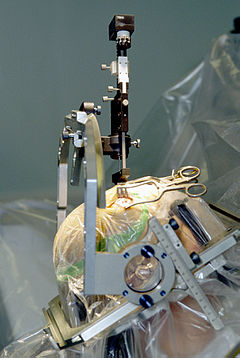
| Home | Sources Directory | News Releases | Calendar | Articles | | Contact | |
Neurosurgery
 |
|
| Insertion of an electrode during neurosurgery for Parkinson's disease. | |
| Occupation | |
|---|---|
| Names | Doctor, Medical Specialist, Surgeon |
| Type | Surgery |
| Activity sectors | Surgery |
| Description | |
| Education required | Doctor of Medicine |
| Fields of employment | Hospitals, Clinics |
Neurosurgery (or Neurological Surgery) is the medical specialty concerned with the prevention, diagnosis, treatment and rehabilitation of disorders that affect the entire nervous system including the brain, spinal column, spinal cord, peripheral nerves, and extra-cranial cerebrovascular system.[1][2]
Contents |
[edit] History
Brain surgery is perhaps the oldest of the medical practices. Africa showed evidence of brain surgery as early as 3,000 B.C. Pre-Incan civilization used brain surgery as early as 2,000 B.C. [3]
[edit] Education and Training
In the United States, a neurosurgeon must generally complete four years of college, four years of medical school, a year-long internship (PGY-1) that is usually affiliated with their residency program, and five to six years of neurosurgery residency (PGY-2-6)[4]. Most, but not all, residency programs have some component of basic science or clinical research. Neurosurgeons may pursue an additional training in a fellowship, after residency or in some cases, as a senior resident. These fellowships include pediatric neurosurgery, neurocritical care, functional and stereotactic surgery, surgical neuro-oncology, neurovascular surgery, Interventional neuroradiology, or skull base surgery.[5]
[edit] Neurosurgical Methods
Neuroradiogy methods are used in modern neurosurgical diagnosis and treatment. computer assisted imaging computed tomography (CT), magnetic resonance imaging (MRI), positron emission tomography (PET), magnetoencephalography (MEG) and the development of stereotactic surgery. Some neurosurgical procedures involve the use of MRI and functional MRI intraoperatively.
Microsurgery is utilized in many aspects of neurological surgery. Microvascular anastomosis are required when EC-IC surgery is performed. The clipping of aneurysms is performed using a microscope. Minimally invasive spine surgery utilizes relies on these techniques. Procedures such as microdiscectomy, laminectomy, and artificial discs rely on microsurgery. [6]
Minimally invasive endoscopic surgery is utilized by neurosurgeons. Techniques such as endoscopic endonasal surgery is used for pituitary tumors, craniopharyngiomas, chordomas, and the repair of cerebrospinal fluid leaks. Ventricular endoscopy is used for colloid cysts and neurocysticercosis. Endoscopic techniques can be used to assist in the evaculation of hematomas and trigeminal neuralgia. Repair of craniofacial disorders and disturbance of cerebrospinal fluid circulation is done by neurosurgeons, and depending on the situation, plastic surgeons. Conditions such as chiari malformation, craniosynostosis, and syringomyelia are treated. This is called cranioplasty.
Neurosurgeons are involved in Stereotactic Radiosurgery along with Radiation Oncologists for tumor and AVM treatment. Radiosurgical methods such as Gamma knife and Cyberknife are used. [7]
Neurosurgeons have began to utilize endovascular image guided procedures for the treatment of aneurysms, AVMs, carotid stenosis, strokes, and spinal malformations, and vasospasms. Also, nonvascular procedures such as Vertoplasty and Kyphoplasty are used by neurosurgeons. Techniques such as angioplasty, stenting, clot retrieval, embolization, and diagnostic angiography are utilized. [8]
[edit] Conditions
Other conditions treated by neurosurgeons include:
- Spinal disc herniation
- Spinal stenosis
- Hydrocephalus
- Head trauma (brain hemorrhages, skull fractures, etc.)
- Spinal cord trauma
- Traumatic injuries of peripheral nerves
- Infections
- Tumours of the spine, spinal cord and peripheral nerves
- Intracerebral hemorrhage, such as subarachnoid hemorrhage, intraparenchymal, and intraventricular hemorrhages
- Some forms of drug-resistant epilepsy
- Some forms of movement disorders (advanced Parkinson's disease, chorea) ' this involves the use of specially developed minimally invasive stereotactic techniques (functional, stereotactic neurosurgery) such as ablative surgery and deep brain stimulation surgery
- Intractable pain of cancer or trauma patients and cranial/peripheral nerve pain
- Some forms of intractable psychiatric disorders
- Vascular malformations (i.e., arteriovenous malformations, venous angiomas, cavernous angiomas, capillary telangectasias) of the brain and spinal cord
- Peripheral neuropathies such as carpal tunnel syndrome and ulnar neuropathy
- Moyamoya disease
[edit] See also
- Harvey Cushing ' Known as the father of neurosurgery
- Gazi Yasargil ' Known as the father of modern microneurosurgery
- Wilder Penfield ' Known as one of the founding fathers of neurosurgery, and pioneer of epilepsy neurosurgery
- Walter Dandy ' Known as one of the founding fathers of neurosurgery
- Brian Andrews (doctor) ' Noted American Neurosurgeon
- Anton Eiselsberg ' Established Neurosurgery as an independent discipline
- Sid Watkins ' World renowned neurosurgeon who served for 26 years as the Formula One Safety and Medical Delegate (race doctor)
- Lars Leksell ' Swedish Neurosurgeon who developed the Gamma Knife
- Frances K. Conley ' Pioneer woman neurosurgeon at Stanford University
- John R. Adler ' Stanford University neurosurgeon who invented the CyberKnife
- Congress of Neurological Surgeons
- Benjamin Carson ' Renowned pediatric neurosurgeon at Johns Hopkins Hospital
- Wirginia Maixner - Pediatric Neurosurgeon at Melbourne's Royal Children's Hospital. Primarily known for separating conjoined Bangladeshi twins, Trishna and Krishna.
- Keith Black - world renowned neurosurgeon specializing in the treatement of brain tumors at Cedars-Sinai Medical Center.
[edit] References
- ^ www.casattexas.com/NEURObody.cfm
- ^ http://www.neurosurgerytoday.org/
- ^ http://www.brain-surgery.com/history.html
- ^ http://www.abns.org/content/primary_certification_process.asp
- ^ http://www.aans.org/medical_students/questions.asp
- ^ http://www.neurosurgery.org/cybermuseum/microneurohall/arhoton.html
- ^ http://neurosurgery.ucla.edu/body.cfm?id=952
- ^ http://www.mir.wustl.edu/neurorad/internal.asp?NavID=74
|
|||||||||||||||||||||||||||||||||||||
|
|||||
|
SOURCES.COM is an online portal and directory for journalists, news media, researchers and anyone seeking experts, spokespersons, and reliable information resources. Use SOURCES.COM to find experts, media contacts, news releases, background information, scientists, officials, speakers, newsmakers, spokespeople, talk show guests, story ideas, research studies, databases, universities, associations and NGOs, businesses, government spokespeople. Indexing and search applications by Ulli Diemer and Chris DeFreitas.
For information about being included in SOURCES as a expert or spokesperson see the FAQ . For partnerships, content and applications, and domain name opportunities contact us.